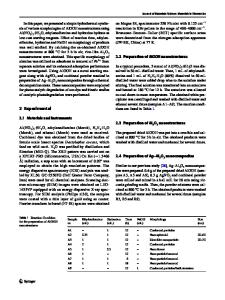Preparation of Al 2 O 3 /Mo nanocomposite powder via chemical route and spray drying
- PDF / 365,410 Bytes
- 9 Pages / 612 x 792 pts (letter) Page_size
- 72 Downloads / 373 Views
MATERIALS RESEARCH
Welcome
Comments
Help
Preparation of Al2 O3yMo nanocomposite powder via chemical route and spray drying Ming-Hung Lo, Feng-Huei Cheng, and Wen-Cheng J. Wei Institute of Materials Science and Engineering, National Taiwan University, Taipei, Taiwan 106, Republic of China (Received 14 December 1995; accepted 9 March 1996)
A route to prepare nanometer-sized Mo particulates in Al2 O3 was attempted by a combination of solution reactions in molecular scale and forcing precipitation by a spray-drying technique. MoO3 was first dissolved in ammonia water and then added in the slurry with high purity, submicrometer Al2 O3 powder. Mixed suspension was spray-dried, and then the dried granules were reduced by hydrogen gas and further hot-pressing to a bulky composite at various temperatures. Dissolution of Mo oxide, adsorption reactions on the alumina surface, and surface potential of alumina particles in homogeneous ammonia suspension were studied. Characterization of the granules, including compactability, flowing properties, surface morphology, grain growth of Mo and Al2 O3 , and mixing homogeneity, were examined. Homogeneity of the spray-dried granules was determined by the calculation of mixing index and the observation of the microstructure of the sintered body. The existence of intergranular, intragranular, and nanosized Mo particulates within Al2 O3 grains was observed by transmission electron microscopy (TEM). All the evidence revealed that homogeneous composites with nanometer-sized Mo had been successfully prepared by this attempt with the proposed chemical roue and following the spray-drying process. I. INTRODUCTION
Nanocomposite, of which nanometer-sized second phase is dispersed within grains and/or grain boundaries of material/matrix, has shown a new class of material combination.1–3 A remarkable improvement on ceramic matrix in both fracture toughness and fracture strength is reported by Niihara et al.4–6 and has attracted a lot of attention from ceramists. Four typical microstructural models with a varied distribution of reinforced particles in matrix grains were also established.7 In reported literature,1–6 composite slurries were processed by using acetone as a solvent, and ball-milled for 24 h to assure a better homogeneity of the slurry before attaining a uniform dry powder for further hot-pressed sintering. However, one of the important key points, the dispersion of fine starting particles in acetone to achieve a finally uniform and homogeneous microstructure and the formation of nanometer-sized particles which are finer than starting particles, has not been well understood in their investigation. On the other hand, during past years, various methods had been attempted to pursue the uniformity and homogeneity of phases in composite. For example, Breval et al.8 fabricated the Al2 O3yNi composite by a sol-gel method, Jange et al.9 obtained a uniform Al2 O3yZrO2ySiCw composite via a so-called “surfaceinduced” coating process, and Hu et al.10 prepared a ZnyZrO2 composite by using a coat
Data Loading...











